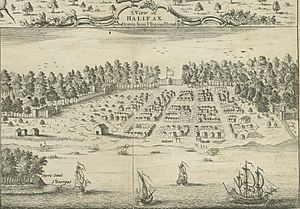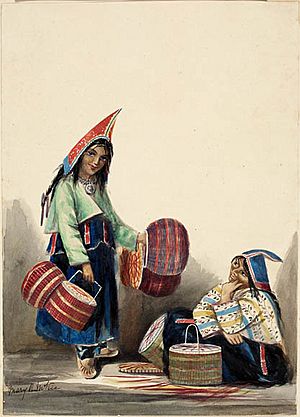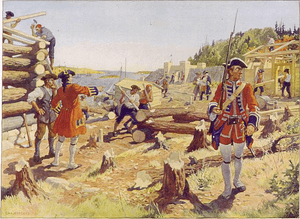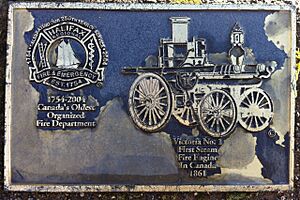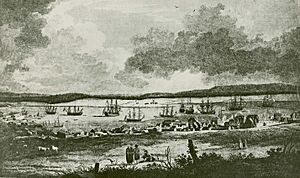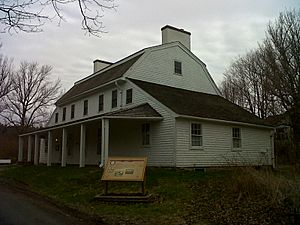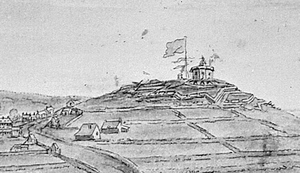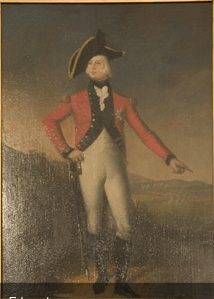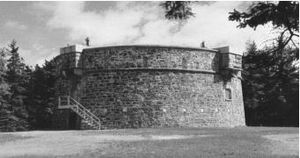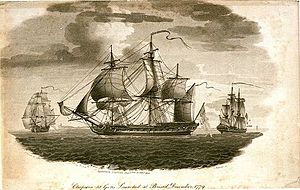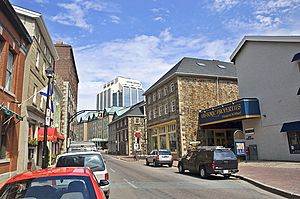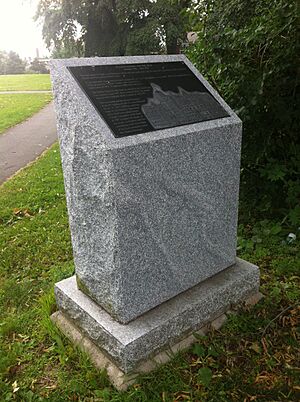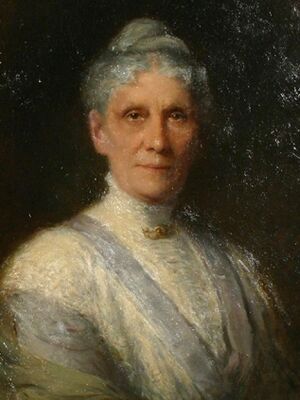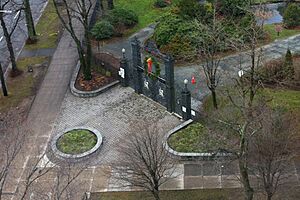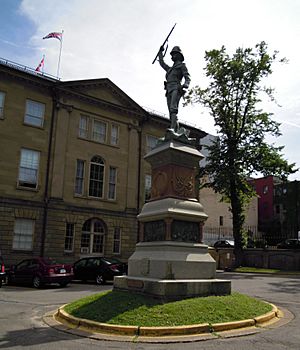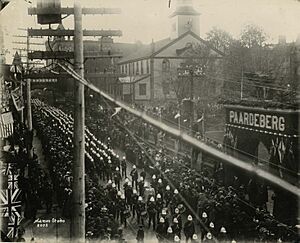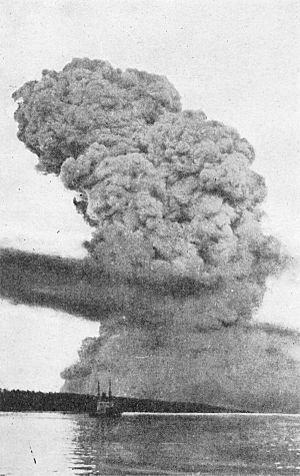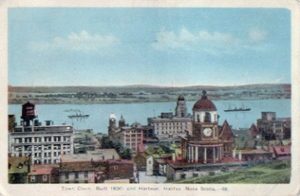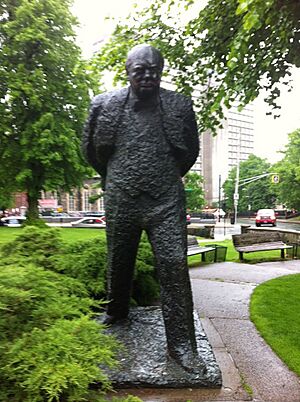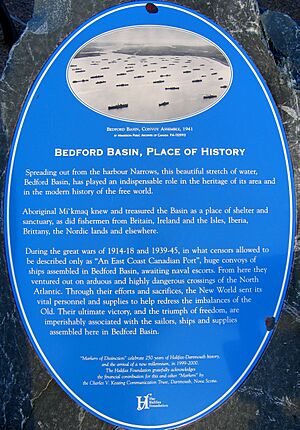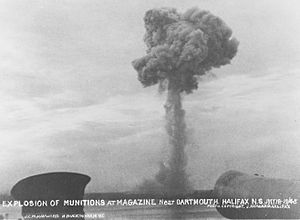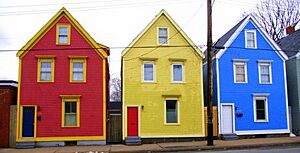History of Halifax, Nova Scotia facts for kids
Quick facts for kids
Halifax
Kji'puktuk (Mi'kmaq)
|
|
|---|---|

Downtown Halifax in July 2007
|
|
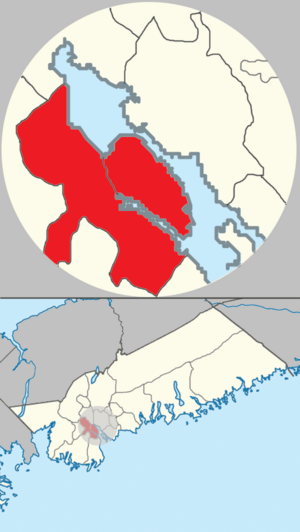
Map of the boundaries of the former Halifax and the relationship to the rest of the regional municipality
|
|
| Country | |
| Province | |
| Municipality | Halifax |
| Founded | 21 June 1749 |
| City | 1842 |
| Amalgamated | 1 April 1996 |
| Area | |
| • Land | 61.961 km2 (23.923 sq mi) |
| Elevation | 0–119 m (0-390 ft) |
| Population
(2021)
|
|
| • Total | 156,141 |
| • Density | 2,519/km2 (6,520/sq mi) |
| Time zone | UTC-4 (AST) |
| • Summer (DST) | UTC-3 (ADT) |
| Canadian Postal code |
B3H to B3S
|
| Area code(s) | 782, 902 |
| GNBC Code | CAPHL |
| NTS Map | 011D12 |
Halifax is a community in Nova Scotia, Canada. It was formed on April 1, 1996. This happened when the cities of Dartmouth and Halifax, the town of Bedford, and Halifax County joined together. They created the Halifax Regional Municipality. The old City of Halifax then became known as the Community of Halifax.
In 2021, the community had 156,141 people living in an area of about 62 square kilometers.
Contents
- History
- The Early Days (18th Century)
- The 19th Century
- Napoleonic Wars
- Halifax Impressment Riot
- War of 1812
- Black Refugees
- Growth in the 19th Century
- Royal Acadian School
- New Horizons Baptist Church
- City Status and Self-Government
- Crimean War
- Schools for the Deaf and the Blind
- American Civil War
- Confederation
- Industrialization
- Transportation to Dartmouth
- Salvation Army
- Anna Leonowens
- North-West Rebellion
- The 20th Century
- The 21st Century
- Geography
- Demographics
- See also
History
The Early Days (18th Century)
The land where Halifax is now has been home to the Miꞌkmaq for a very long time. They called the area around Halifax Harbour Jipugtug, which means "Great Harbour." Before Europeans arrived, Mi'kmaq families would spend summers by the water. They would move inland before the cold Atlantic winter.
French settlers were the first Europeans to arrive in the early 1600s. They started a colony called Acadia. Then, in 1749, the British settled Halifax. This led to a conflict known as Father Le Loutre's War. To protect their new settlements, the British built forts in Halifax (Citadel Hill), Bedford (Fort Sackville), Dartmouth, and Lawrencetown.
The British founded the Town of Halifax in 1749. It was named after the Earl of Halifax. The capital of the colony was moved here from Annapolis Royal.
Father Le Loutre's War
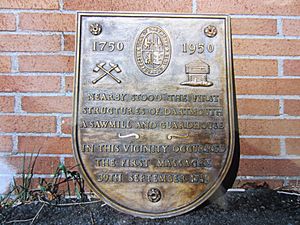
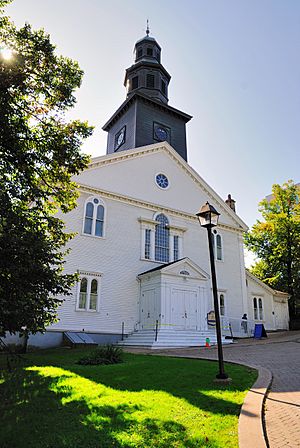
The founding of Halifax started Father Le Loutre's War. On June 21, 1749, Edward Cornwallis arrived to establish Halifax. The British were breaking earlier agreements with the Mi'kmaq by doing this. Cornwallis brought many settlers with him. In 1750, more immigrants arrived and settled on the eastern side of Halifax Harbour, starting the town of Dartmouth.
During the war, the Mi'kmaq and Acadians attacked Halifax and Dartmouth many times. In September 1749, Mi'kmaq attacked men cutting trees in Dartmouth. Four men were killed. After this, Cornwallis offered a reward for capturing Mi'kmaq.
In July 1750, Mi'kmaq killed seven men working in Dartmouth. Dartmouth was attacked again in September 1750, and five more people were killed. In March 1751, another attack killed fifteen settlers.
Dartmouth Massacre
The worst attack was the Dartmouth Massacre in May 1751. Sixty Mi'kmaq and Acadians attacked Dartmouth. They killed twenty settlers and took others prisoner. They also destroyed buildings.
Attacks continued on blockhouses (small forts) around Halifax. In 1753, Mi'kmaq attacked sawmills near the South Blockhouse, killing three British men. A well-known Halifax businessman, Michael Francklin, was captured by a Mi'kmaq group in 1754. He was held for three months.
French and Indian War
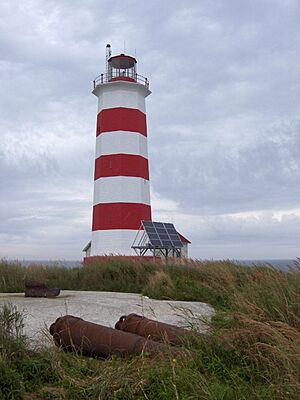

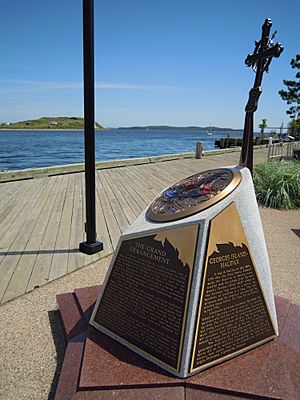
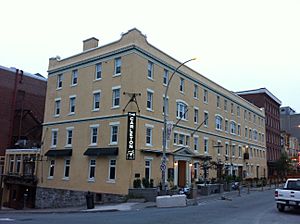
Halifax was very important as a military base during the French and Indian War (also known as the Seven Years' War). It was used to fight against the French fortress of Louisbourg. Halifax was the base for the Siege of Louisbourg (1758). Acadians who were forced to leave their homes were imprisoned on Georges Island (Nova Scotia) in Halifax Harbour.
In 1757, Acadian leader Pierre Gautier led Mi'kmaq warriors in three raids against Halifax. They took prisoners each time. By June 1757, settlers had to leave Lawrencetown because of the many raids.
In 1759, there was another Mi'kmaq attack on Eastern Battery in Dartmouth. Five soldiers were killed. After the French took St. John's, Newfoundland, in 1762, Acadians and Natives became more confident. The government then forced 1,300 Acadians to leave, sending them to Boston.
In 1759, a permanent navy base, the Halifax Naval Yard, was built. Halifax was a frontier area for the British military. Many early settlers left for other cities. However, new people arrived, including Germans, Dutch, and New Englanders. This led to names like "Dutch Village Road" in Halifax.
Burying the Hatchet Ceremony
After many years of war, peace treaties were signed between the British and the Mi'kmaq. On June 25, 1761, a "Burying of the Hatchet Ceremony" was held in Halifax. This marked the end of a 75-year period of conflict. Nova Scotians now celebrate Treaty Day every October 1st to remember these treaties.
Halifax's importance changed with the needs of the British Empire. After peace in 1763, the military presence was reduced. By the mid-1770s, the town faced its first quiet period.
The American Revolution
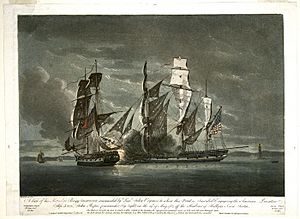
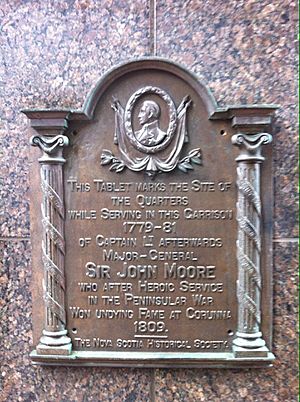
The American Revolutionary War greatly impacted Halifax. In March 1776, General William Howe arrived with thousands of soldiers and loyalist refugees from Boston. Halifax became a key base for British attacks on rebel areas. Thousands more refugees, often in great need, arrived in Halifax throughout the war.
After the war, many Loyalists from the American colonies settled in Halifax. Many of their descendants still live in the city today.
Dartmouth grew slowly. In 1785, Quakers from Nantucket arrived to start a whaling business. They built homes and a factory. This was profitable, but they moved to Wales around 1795. Only one Quaker house remains in Dartmouth.
Prince Edward, Duke of Kent and Strathearn
Prince Edward, Duke of Kent and Strathearn, the father of Queen Victoria, lived in Halifax from 1794 to 1800. He was the Commander-in-Chief for North America. He had a big impact on the city's military defenses. He also designed famous buildings like the Prince of Wales Tower, the Halifax Town Clock on Citadel Hill (Fort George), and St. George's (Round) Church.
The 19th Century
By the early 1800s, Dartmouth had about twenty-five families. Within twenty years, it had sixty houses, a church, and shipyards.
Napoleonic Wars
Halifax became a strong British base on the East Coast of North America. The city grew a lot during the Napoleonic Wars. Military spending and wartime trade helped the economy boom.
Prince Edward, Duke of Kent, helped design many of the city's forts. He left a lasting mark on Halifax with its Georgian architecture. During his time, Halifax truly became a city. Many landmarks were built, and the population grew.
Halifax Impressment Riot
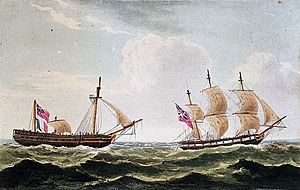
In 1805, the British Royal Navy needed more sailors. They used "press gangs" to force men into service. In May, press gangs from warships went into downtown Halifax. They took many men, asking questions later.
In October 1805, press gangs from HMS Cleopatra stormed Halifax streets with bayonets. This caused a big riot where one person was killed and others were hurt. This event led to stricter rules on recruiting in Nova Scotia.
War of 1812

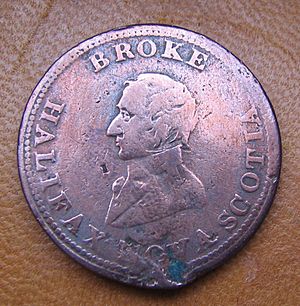

Halifax continued to grow during the War of 1812. The Royal Navy base in Halifax became very important. It made sure Halifax was never attacked. The Naval Yard expanded and even built some smaller warships.
One famous event was the capture of the American frigate USS Chesapeake by the Halifax-based British frigate HMS Shannon. This was a major victory for the British. The captured Chesapeake was brought to Halifax. Many American prisoners were held on Melville Island.
In 1813, a force from Halifax attacked Washington D.C., burning the U.S. Capitol and White House. The money gained from this conquest helped start Dalhousie University, which is now Atlantic Canada's largest university.
Saint Mary's University was founded in 1802 as an elementary school. It became a college after Dalhousie University was established in 1819.
Black Refugees
Between 1813 and 1815, many Black Refugees from the United States settled in Nova Scotia. They made homes in places like Hammonds Plains, Beechville, Lucasville, and Africville.
Growth in the 19th Century
After 1815, Halifax's economy slowed down for a few years. But it recovered, led by successful local business people like Samuel Cunard (who started the Cunard Line) and banker Enos Collins. Halifax became a major financial center in British North America. The City of Halifax was officially incorporated in 1842.
Many important businesses started in Halifax during the 19th century, including the Starr Manufacturing Company and Alexander Keith's Brewery. A modern water system was built in 1844.
Halifax was an important British military base. Its harbor defenses were constantly improved. The city grew during the American Civil War by supplying both sides. It also saw Canada's first overseas military deployment in the Second Boer War.
Halifax was founded below a hill called Citadel Hill. The city was named after the Earl of Halifax. Halifax Harbour is one of the largest natural harbors in the world, making it ideal for a military base.
Royal Acadian School
In 1814, Walter Bromley opened the Royal Acadian School. It welcomed many Black children and adults. Some Black students started businesses in Halifax, while others became servants.
New Horizons Baptist Church
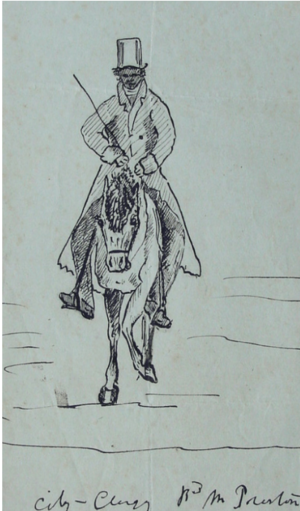
New Horizons Baptist Church was founded by Black Refugees in 1832. It was originally called the African Chapel. This church became a symbol of pride for Black citizens. Under Richard Preston, the church became a center for social action for Black Nova Scotians.
Preston helped establish a network of Black Baptist churches across Nova Scotia. The Halifax church was known as the "Mother Church." These churches also created groups like the African Friendly Society and the African Abolition Society.
City Status and Self-Government
After a long effort, Halifax became an official city in 1842. The fight for self-government in Halifax helped start the political career of Joseph Howe. He is considered the father of responsible government in British North America. In 1848, Nova Scotia became the first British colony to achieve responsible government.
In the 1850s, Howe promoted railways. Halifax became connected by rail to other parts of Canada and New England in the 1870s.
Crimean War

People from Halifax fought in the Crimean War. The Welsford-Parker Monument in Halifax is the oldest war monument in Canada (1860). It remembers the Siege of Sevastopol (1854–1855).
Dartmouth saw many new industries in the 1850s. The Starr Manufacturing Company made ice skates and other iron products. Other factories produced candy, soap, and rope. As the population grew, new homes and businesses appeared.
Schools for the Deaf and the Blind
The first school for the deaf in Atlantic Canada, the Halifax School for the Deaf, opened in 1856. The Halifax School for the Blind opened in 1871. It was the first residential school for the blind in Canada.
American Civil War
The American Civil War brought a lot of activity and wealth to Halifax. Most people supported the North, and many volunteered to fight for the Union Army. However, some merchants in the city made money by selling supplies to both sides. Blockade runners and Confederate ships often stopped in Halifax for supplies and repairs.
One famous event was the escape of the Confederate ship CSS Tallahassee. It sailed into Halifax Harbour for supplies. Two Union Navy ships were waiting to capture it. But the Tallahassee slipped out of the harbor at night through a hidden passage, avoiding capture.
Confederation
After the American Civil War, the British North American colonies decided to unite. This was partly due to a threat from the United States. Canadian Confederation happened in 1867. Many people in Halifax were against it because the city was already wealthy and had strong trade ties with the US.
Halifax kept its British military until 1906. The British Royal Navy stayed until 1910, when the new Royal Canadian Navy took over the Naval Dockyard.
The city's culture grew. The Victorian College of Art was founded in 1887. The province's Public Archives and museum were also started around this time.
Industrialization
Halifax tried to grow its manufacturing industries. Factories like the Acadia Sugar Refinery and the Halifax Graving Dock were built. However, it was hard for Halifax companies to compete with larger firms in Ontario and Quebec.
Transportation to Dartmouth
In 1873, Dartmouth became an official town. A railway station was built in 1885, and passenger service began in 1886. There were attempts to build a railway bridge across Halifax Harbour, but storms destroyed them.
Salvation Army
On March 24, 1881, George Scott Railton held the first Salvation Army meeting in Canada in Halifax. He missed his boat to England because he was so focused on his sermon. The Salvation Army was officially established in Canada a year later.
Anna Leonowens
Anna Leonowens lived in Halifax for 19 years (1878-1897). She had a big impact on the city's culture and society. She supported women's education and helped found the Local Council of Women of Halifax and the Woman's Suffrage Association, which fought for women's right to vote. She also helped start the Nova Scotia College of Art and Design.
North-West Rebellion
Before the North-West Rebellion, Nova Scotia was not very happy about being part of Canada. But when the Halifax Provisional Battalion returned from the conflict, their celebration sparked a new sense of national pride in Nova Scotia. This event helped unite Nova Scotia with the rest of Canada.
The 20th Century
Second Boer War
During the Second Boer War (1899-1902), Canadian soldiers, including 125 men from Nova Scotia, served overseas. This was the first time large groups of Nova Scotian troops fought abroad. About 267 Canadians died in the war.
Halifax and Southwestern Railway
In 1901, the Halifax and Southwestern Railway (H&SW) was planned. It would connect Halifax to Yarmouth along the South Shore. This railway was important for transportation before highways became common. Construction finished in 1906. The H&SW later became part of the Canadian National Railways (CNR) in 1918.
Titanic Disaster
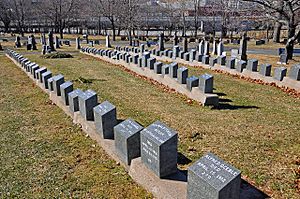
In April 1912, Halifax became the center for recovering bodies after the sinking of the RMS Titanic. Two Halifax ships, CS Mackay-Bennett and CS Minia, were sent to the disaster site.
Only 333 bodies were found out of over 1,500 victims. Most of the recovered victims were buried in three Halifax cemeteries. Relatives came from all over North America to identify bodies.
World War I
Halifax's harbor was very important during both world wars. In World War I, it became a major port and naval facility. Its protected waters in Bedford Basin sheltered convoys (groups of ships traveling together) from German U-boat attacks.
Halifax's railway connections and port facilities were vital for the British war effort. Canadian soldiers left for overseas from Halifax. The city also served as a meeting point for all convoys. New gun batteries and an anti-submarine net defended the harbor.
Halifax Explosion
On December 6, 1917, a French ship carrying explosives, Mont-Blanc, collided with a Norwegian ship, Imo. The munitions ship exploded at 9:04:35 AM. This was the largest man-made explosion before the first atomic bomb test.
The Halifax Explosion destroyed the city's north end. About 2,000 people were killed, 9,000 were injured, and tens of thousands lost their homes. The next day, a blizzard hit, making recovery efforts harder. Help came from across North America and around the world. As a thank you, Nova Scotia has donated the annual Christmas tree to Boston since 1971.
The explosion and the rebuilding changed the city. New housing developments like the Hydrostone were built. Railways were moved to the South End of the city.
Between the Wars
The city's economy slowed after World War I. However, rebuilding from the Halifax Explosion brought new homes and the Halifax Shipyard. The Great Depression in 1929 made things even harder. One positive development was the completion of Pier 21, a large complex for freight and immigrants.
Halifax opened its first civilian airport, Chebucto Field, in 1931.
World War II
Halifax played an even bigger role in World War II. It became a vital link for sending supplies to Britain during the Battle of the Atlantic. Many convoys gathered in Bedford Basin before heading to Europe. The harbor was an essential base for Canadian, British, and Allied warships.
The city was never attacked, but people lived with fears of German raids. Housing and transportation were very strained. The war ended with a large riot in Halifax on VE Day in May 1945.
Bedford Magazine Explosion
On July 18, 1945, near the end of World War II, a fire started at the magazine jetty on the Bedford Basin. It spread to the dock, and stored ammunition exploded. This caused a series of violent explosions.
Halifax Riot
The Halifax Riot happened on VE-Day, May 7–8, 1945. It started as a celebration of the end of World War II in Europe. But it quickly turned into looting by thousands of servicemen and civilians. The riot was caused by many factors, including too many servicemen for the city's resources.
Postwar Years
After World War II, Halifax's economy did not slump as it had after previous wars. This was partly due to the Cold War, which meant continued spending on the Canadian navy. The city also benefited from a more diverse economy and growth in government services and education.
In the late 1960s, Halifax grew significantly. Nearby areas like Princes Lodge, Rockingham, Clayton Park, Fairview, Armdale, and Spryfield became part of the city.
There were plans in the 1940s to demolish Halifax Citadel. But people realized its historical importance, and it was saved in 1956. It is now a major tourist attraction.
In the 1960s and 1970s, urban renewal plans led to the loss of many historic buildings. However, citizen protests stopped further destructive plans, like a waterfront freeway. This led to a successful revitalization of the waterfront.
The Black community of Africville was declared a slum in the 1960s. It was demolished, and its residents were forced to move. This was done to clear land for industrial use and a bridge. The effects of this continue today.
In 1980, Bedford became a separate town. In the 1990s, development spread outside the peninsula. The Bayers Lake Business Park was built, bringing large stores to the area.
1996 Amalgamation and Community Status
The provincial government wanted to reduce the number of local governments to save money. On April 1, 1996, the Town of Bedford, the City of Dartmouth, the City of Halifax, and Halifax County all joined together. They formed the Halifax Regional Municipality. The City of Halifax then became known as the Community of Halifax.
Even though the cities were dissolved, people still often refer to their local area by its old name, like Dartmouth or Halifax.
The 21st Century
In the late 1990s, Halifax's music scene became well-known. Bands like Sloan and Sarah McLachlan came from the area.
In 2003, a plan was signed to build sewage treatment plants for the main urban area. This meant that for the first time, human sewage would be treated before going into the Atlantic Ocean.
Hurricane Juan
On September 29, 2003, Hurricane Juan hit Halifax. It was the strongest hurricane to directly hit the area since 1893. The storm caused major power outages. Some rural areas were without electricity for up to two weeks. Millions of trees were damaged or destroyed.
On January 13, 2008, the government of Nova Scotia gave the Halifax Regional Municipality more powers to meet its specific needs.
Africville Apology
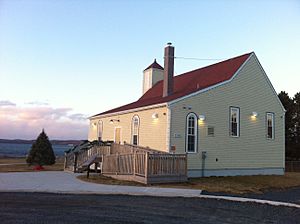
On February 24, 2010, Halifax Mayor Peter J. Kelly made the Africville Apology. He apologized for the eviction of people from Africville. The city restored the name Africville to Seaview Park. The Seaview African United Baptist Church, which was torn down in 1969, was rebuilt in 2011. It now serves as a church and a center for learning about Africville's history.
Geography
The community of Halifax covers about 62 square kilometers. This is less than 1.2% of the total municipal land area.
Halifax is located in the Atlantic Maritime region. It has a wet climate and mixed forests.
Historical Political Geography
The first settlements in Halifax were on a small piece of land at the foot of Citadel Hill. Over time, Halifax grew to include all parts of the peninsula.
In 1969, the City of Halifax grew a lot. It added several communities from Halifax County, including Armdale, Clayton Park, Fairview, Purcell's Cove, Rockingham, and Spryfield.
On April 1, 1996, the City of Dartmouth, the City of Halifax, Halifax County, and the Town of Bedford all joined together. They formed the Halifax Regional Municipality. The City of Halifax then became the Community of Halifax, with the same boundaries as the former city.
The streets on the Halifax peninsula are set up in a grid, which makes it easy to find your way around. Streets are numbered from south to north and east to west.
Neighbourhoods
- Common neighbourhood names
- North End Halifax: North of North Street to Seaview Park
- West End, Halifax: West of Windsor Street, between North and South Streets to Joseph Howe Drive
- Quinpool District: A popular shopping and dining area
- South End Halifax: South of South Street to Point Pleasant Park
- Spring Garden: Another shopping and dining area
- Central Halifax: The original city area, between North Street and South Street, from Lower-Water Street to Windsor Street
- Official neighbourhood names
(including former villages, residential areas, and modern developments)
- Armdale
- Bayer's Lake
- Clayton Park
- Fairview
- Hydrostone: A neighborhood rebuilt after the Halifax Explosion
- Jollimore
- Rockingham
- Spryfield
- Historic neighbourhood names
- Africville: Now Seaview Park
- Richmond: Now part of the North End
- Needham (Halifax): Now the Hydrostone and part of the North End
- Dutch Village: Part of the West End
Demographics
The community of Halifax has its highest population ever. In 2021, it had 156,141 people. If it were still a separate city, it would be the largest city in Atlantic Canada.
From 2016 to 2021, the population grew by 19,621 people. This was a strong growth of more than 14% in five years.
| Census Tract | Land area (km2) | Population (2021) | Population (2016) | Population Density (people per km2) (2021) | Population Change (%) |
|---|---|---|---|---|---|
| 2050001.00 | 5.703 | 4,123 | 3,868 | 722 | |
| 2050002.00 | 11.518 | 8,358 | 6,194 | 725 | |
| 2050003.00 | 2.365 | 2,885 | 2,955 | 1,219 | |
| 2050004.01 | 0.481 | 4,045 | 3,466 | 8,402 | |
| 2050004.02 | 0.482 | 5,466 | 4,771 | 11,340 | |
| 2050005.00 | 0.769 | 1,813 | 1,808 | 2,358 | |
| 2050006.00 | 1.054 | 3,553 | 3,129 | 3,371 | |
| 2050007.00 | 1.16 | 1,947 | 1,859 | 1,677 | |
| 2050008.00 | 0.504 | 5,203 | 2,778 | 10,325 | |
| 2050009.00 | 0.635 | 2,875 | 2,357 | 4,528 | |
| 2050010.00 | 0.834 | 6,019 | 5,036 | 7,213 | |
| 2050011.00 | 0.808 | 6,013 | 5,631 | 7,446 | |
| 2050012.00 | 0.518 | 2,901 | 2,482 | 5,598 | |
| 2050013.00 | 0.805 | 2,630 | 2,561 | 3,267 | |
| 2050014.00 | 1.838 | 4,390 | 4,248 | 2,388 | |
| 2050015.00 | 2.042 | 5,389 | 4,829 | 2,639 | |
| 2050016.00 | 2.563 | 4,021 | 3,766 | 1,568 | |
| 2050017.00 | 2.912 | 2,999 | 2,914 | 1,029 | |
| 2050018.00 | 1.397 | 3,758 | 3,544 | 2,690 | |
| 2050019.00 | 0.891 | 5,126 | 5,062 | 5,755 | |
| 2050020.00 | 0.999 | 3,602 | 2,562 | 3,607 | |
| 2050021.00 | 0.877 | 3,544 | 3,314 | 4,041 | |
| 2050022.00 | 2.833 | 5,581 | 5,301 | 1,969 | |
| 2050023.00 | 1.537 | 5,208 | 4,594 | 3,388 | |
| 2050024.00 | 2.181 | 8,618 | 7,375 | 3,951 | |
| 2050025.01 | 1.05 | 5,201 | 4,726 | 4,953 | |
| 2050025.02 | 1.913 | 5,515 | 4,863 | 2,882 | |
| 2050025.04 | 0.911 | 4,818 | 4,685 | 5,288 | |
| 2050025.05 | 1.556 | 3,746 | 3,547 | 2,407 | |
| 2050026.02 | 1.509 | 4,855 | 3,409 | 3,217 | |
| 2050026.03 | 1.393 | 3,348 | 3,358 | 2,403 | |
| 2050026.04 | 0.654 | 4,346 | 4,199 | 6,645 | |
| 2050026.05 | 0.771 | 3,866 | 3,967 | 5,014 | |
| 2050027.00 | 4.498 | 10,379 | 7,362 | 2,307 | |
| Community | 61.961 | 156,141 | 136,520 | 2,519 |
| Historical community population | ||
|---|---|---|
| Year | Pop. | ±% |
| 1749 | 2,576 | — |
| 1755 | 1,747 | −32.2% |
| 1762 | 2,500 | +43.1% |
| 1767 | 3,695 | +47.8% |
| 1790 | 4,000 | +8.3% |
| 1817 | 5,341 | +33.5% |
| 1828 | 14,439 | +170.3% |
| 1841 | 14,422 | −0.1% |
| 1851 | 20,749 | +43.9% |
| 1861 | 25,026 | +20.6% |
| 1871 | 29,582 | +18.2% |
| 1881 | 36,100 | +22.0% |
| 1891 | 38,437 | +6.5% |
| 1901 | 40,832 | +6.2% |
| 1911 | 46,619 | +14.2% |
| 1921 | 58,372 | +25.2% |
| 1931 | 59,275 | +1.5% |
| 1941 | 70,488 | +18.9% |
| 1951 | 85,589 | +21.4% |
| 1961 | 92,511 | +8.1% |
| 1971 | 122,035 | +31.9% |
| 1981 | 114,594 | −6.1% |
| 1991 | 114,455 | −0.1% |
| 1996 | 113,910 | −0.5% |
| 2001 | 119,292 | +4.7% |
| 2006 | n/a | — |
| 2011 | n/a | — |
| 2016 | 136,520 | — |
| 2021 | 156,141 | +14.4% |
| From 1749 until 1842; Halifax was a Town. From 1842 until 1996; Halifax was a City. From 1996 until present; Halifax has been a Community. | ||
See also
- Black Nova Scotians
- History of Dartmouth
- History of Nova Scotia
- List of mayors of Halifax, Nova Scotia
- List of people from the Halifax Regional Municipality
- Military history of Nova Scotia



